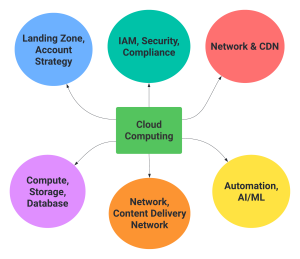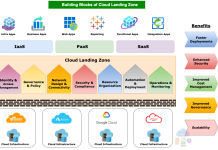Cloud computing has revolutionized IT infrastructure, offering businesses scalability, flexibility, and cost-efficiency. In simpler terms, it’s the delivery of computing services (servers, storage, databases, networking, software, analytics, and intelligence) over the internet (“the cloud”). Instead of owning and managing physical hardware, businesses can now access computing resources on-demand over the internet. This offers incredible flexibility, scalability, and cost savings. Whether you’re a seasoned cloud professional or just starting your journey, this blog post will provide a solid foundation in cloud computing concepts and introduce you to the major players in the industry.
Further, this guide delves into exploring core concepts, optimization strategies, and future trends at high level. Whether you’re new to the cloud or an experienced professional, this resource will help you make informed decisions and architect robust cloud solutions.
1. A Multitude of Cloud Providers: Finding Your Perfect Fit
The world of cloud computing offers a vast selection of service providers, each vying for your attention. Understanding these Cloud Service Providers (CSPs) is crucial for making informed decisions when building your IT infrastructure to architect cloud ready applications.
Read: Cloud Computing Basics and Fundamental Concepts
The cloud landscape is dominated by a few major players: Amazon Web Services (AWS), Microsoft Azure, Google Cloud Platform (GCP), and Oracle Cloud Infrastructure (OCI). Each offers a suite of foundational services:
The Big Four Cloud Providers:
1) Amazon Web Services (AWS): A pioneer in cloud computing, AWS offers a vast array of services, from compute and storage to databases and AI/ML tools. It’s known for its maturity and global reach.
- Services: Amazon EC2 (virtual machines), Amazon S3 (object storage), Amazon RDS (relational database service), Amazon CloudFront (CDN), AWS Lambda (serverless computing), Amazon SageMaker (AI/ML platform).
2) Microsoft Azure: A formidable competitor, Azure seamlessly integrates with existing Microsoft products and offers a familiar experience for those using on-premises Microsoft infrastructure. It boasts a vast global network of data centers.
- Services: Azure Virtual Machines, Azure Blob Storage, Azure SQL Database, Azure CDN, Azure Functions (serverless computing), Azure Machine Learning.
3) Google Cloud Platform (GCP): GCP is recognized for its cutting-edge AI/ML capabilities, data analytics tools, and focus on innovation. It often offers competitive pricing and excellent support.
- Services: Compute Engine (virtual machines), Cloud Storage (object storage), Cloud SQL (relational database service), Cloud CDN, Cloud Functions (serverless computing), Google AI Platform (AI/ML platform).
4) Oracle Cloud Infrastructure (OCI): OCI provides enterprise-grade solutions with a focus on autonomous technologies and robust security features. It’s a compelling option for businesses with demanding workloads or specific database needs.
- Services: Virtual Machines, Cloud Storage, Autonomous Database, Oracle Cloud Infrastructure CDN, Oracle Functions (serverless computing), Oracle Cloud AI and Machine Learning.
Read: Major Cloud Platforms evaluation – An Cloud architect’s perspective
Beyond the Basics: Key Considerations
While these providers offer core functionalities, consider these factors when making your choice:
- Pricing: Models include pay-as-you-go, subscriptions, and reserved instances. Factor in commitment levels and usage patterns. Look for free tiers or credits to experiment.
- Focus: Is your priority AI/ML (GCP), seamless Microsoft integration (Azure), or vast breadth of services (AWS)?
- Global Reach: Data center locations impact latency and may be crucial for compliance with data regulations.
- Customer Support: The level of support needed, especially for production environments, can be a significant differentiator.
- User Interface: Each platform has a distinct interface. Consider the learning curve for your team.
Beyond the Big Four:
The “Big Four” are not the only players in the cloud computing market. Depending on your specific needs and budget, there might be smaller, niche providers that offer a better fit.
Security Considerations:
Remember, cloud security is a shared responsibility. While cloud providers offer robust security features, it’s crucial to understand the shared responsibility model and implement your own security measures to protect your data.
By considering these factors, you can navigate the world of cloud providers and find the perfect fit for your business and IT needs.
2. Exploring Core Cloud Services
Several companies offer cloud services, each with its own strengths and pricing structures. This article focuses on four major players: Amazon Web Services (AWS), Microsoft Azure, Google Cloud Platform (GCP), and Oracle Cloud Infrastructure (OCI). Let’s delve into the essential services they offer:
a. Cloud Landing Zone Services:
Imagine a blueprint for your cloud environment. A landing zone is a pre-configured template that establishes a secure foundation. It defines best practices for security, access, networking, and resource management. Each provider offers tools and guidance for creating landing zones. Learn in-depth: What are Cloud Landing Zones and its core architecture components.
-
- AWS: AWS Control Tower, AWS Well-Architected Framework and Landing Zone reference architectures provide blueprints. Read the complete guide on AWS Landing Zone architecture.
- Azure: Azure offers reference architectures and tools like Azure Resource Manager (ARM) templates and Azure Landing zone accelerator. Read the complete guide on Azure Landing Zone architecture.
- GCP: Offers landing zone best practices and tools for design, deployment, and management. Read the complete guide on GCP Landing Zone architecture.
- Oracle Cloud: Oracle Cloud Landing Zone provides pre-configured policies and guidelines. Read the complete guide on Oracle Cloud Landing Zone architecture.
b. Account Strategy Services:
Structuring your cloud presence effectively with multiple accounts or subscriptions enables granular management of access, costs, and resource separation. Consider factors such as development/test/production environments, business units, or project isolation when designing your account strategy. Explore Global Cloud architectures and their Governance strategy
-
- AWS: AWS Organizations for managing multiple accounts.
- Azure: Azure Subscriptions for managing individual accounts.
- GCP: GCP Projects within a GCP Organization for managing resources and billing.
- Oracle Cloud: Oracle Cloud compartments to organize OCI resources and manage access.
c. Identity and Access Management (IAM) Services:
The cornerstone of security, IAM controls who can access and manipulate your cloud resources. IAM systems in AWS, Azure, GCP, and OCI provide granular permissions and the principle of least privilege.
-
- AWS: AWS IAM for managing users, groups, and permissions.
- Azure: Azure Active Directory for identity and access management.
- GCP: GCP IAM for managing identities and access control.
- Oracle Cloud: Oracle Cloud IAM for managing users, groups, and policies.
d. Security and Compliance Services:
Cloud providers offer built-in tools alongside a shared responsibility model where you also play a crucial role in securing your environment. Strict compliance certifications may be essential depending on your industry. Remember, cloud security is a partnership between you and your provider.
Read: Cloud Security Basics and Fundamentals
- AWS: AWS Security Hub, AWS Config, AWS Shield
- Azure: Azure Security Center for security posture management, Azure Defender for threat protection.
- GCP: Cloud Security Command Center for security posture management, Chronicle for security analytics.
- Oracle Cloud: Oracle Cloud Guard for threat detection and remediation.
e. Compute Services:
Provides the processing power to run your applications in the cloud, offering options like virtual machines, containers, and serverless computing. All major providers offer various compute options.
Read: Virtualization Basics and Fundamentals
- AWS: Amazon EC2 (virtual machines), Amazon ECS (container orchestration), AWS Lambda (serverless computing).
- Azure: Azure Virtual Machines, Azure Kubernetes Service (AKS) for container orchestration, Azure Functions (serverless computing).
- GCP: Compute Engine (virtual machines), Google Kubernetes Engine (GKE) for container orchestration, Cloud Functions (serverless computing).
- Oracle Cloud: Virtual Machines, Container Engine for Kubernetes (OKE) for container orchestration, Oracle Functions (serverless computing).
f. Storage Services:
Stores your data securely and reliably in the cloud, with various solutions like object storage, block storage, and file storage. Each provider offers a range of storage solutions.
Read: Storage Basics and Fundamentals
-
- AWS: Amazon S3 (object storage), Amazon EBS (block storage), Amazon EFS (file storage).
- Azure: Azure Blob Storage (object storage), Azure Disks (block storage), Azure Files (file storage).
- GCP: Cloud Storage (object storage), Cloud Storage disks (block storage), Cloud Filestore (file storage).
- Oracle Cloud: Cloud Storage (object storage), Block Volumes (block storage), File Systems (file storage).
g. Database Services:
Manage your structured and unstructured data efficiently with managed database services. All major providers offer various database solutions.
-
- AWS: Amazon RDS (relational database service), Amazon DynamoDB (NoSQL database), Amazon Aurora (relational database)
- Azure: Azure SQL Database (managed relational SQL service), Azure Cosmos DB (globally distributed NoSQL database), Azure Database for PostgreSQL, MySQL etc.
- GCP: Cloud SQL (managed relational database service), Cloud Spanner (globally distributed relational database), Cloud Firestore (NoSQL document database)
- OCI: Autonomous Database (self-driving, highly scalable relational database service), Database Service for popular databases like MySQL and PostgreSQL
h. Network Services:
Enables communication between your cloud resources and the outside world, allowing secure connections to the internet and on-premises infrastructure. Each provider offers its own networking solutions.
Read: Network Basics and Fundamentals
- AWS: Amazon VPC (Virtual Private Cloud), Amazon Route 53 (domain name system management), AWS Transit Gateway (connecting VPCs).
- Azure: Azure Virtual Network (VNets), Azure Private DNS for internal DNS management, Azure ExpressRoute for private connections to an on-premises network.
- GCP: Virtual Private Cloud (VPC), Cloud DNS for managing domain names, Cloud Load Balancing for distributing traffic across applications.
- Oracle Cloud: Virtual Cloud Network (VCN) with public and private subnets, Oracle Cloud Infrastructure DNS for domain management, FastConnect for private connections to an on-premises network.
g. Content Delivery Network (CDN) Services:
Improves website performance and user experience by caching content globally. All major providers offer CDN services to ensure faster delivery for your users.
-
- AWS: Amazon CloudFront is a CDN service that delivers content with low latency and high transfer speeds.
- Azure: Azure Content Delivery Network (CDN) is a high-performance service for globally distributing your static content.
- GCP: Cloud CDN is a global network of edge locations that cache content for faster delivery to users.
- Oracle Cloud: Oracle Cloud Infrastructure Content Delivery Network for distributing static content with high performance and global reach.
h. Automation Services:
Automating cloud tasks increases efficiency and reduces human error. Each provider offers automation tools, letting you focus on innovation.
-
- AWS: AWS CloudFormation for infrastructure automation, AWS Step Functions for orchestration of workflows.
- Azure: Azure Automation for automating tasks and configurations, Azure Logic Apps for building workflows.
- GCP: Cloud Deployment Manager for infrastructure automation, Cloud Workflows for building serverless workflows.
- Oracle Cloud: Terraform (open-source tool) for infrastructure automation, Oracle Cloud Resource Manager for managing and automating cloud resources.
i. Machine Learning & Artificial Intelligence (AI/ML) Services:
These services provide tools and infrastructure to leverage the power of AI and ML for various applications. All major providers offer AI/ML services.
-
- AWS: Amazon SageMaker is a comprehensive platform for building, training, and deploying machine learning models.
- Azure: Azure Machine Learning is a cloud-based service for developing, managing, and deploying ML models.
- GCP: Google AI Platform offers a suite of tools for building and deploying machine learning models, including Vertex AI.
- Oracle Cloud: Oracle Cloud Infrastructure Data Science for building, training, and managing machine learning models in an integrated environment.
Read: How to integrate GenAI services into existing architectures
Understanding core cloud services empowers you to make informed decisions when building your cloud infrastructure. Remember, this is just the tip of the iceberg. Each service offers a wide range of features and functionalities to explore. By leveraging the resources and documentation offered by cloud providers, you can unlock the full potential of the cloud and transform your business.
Here is the table summarising all the above cloud services across AWS, Azure, GCP and OCI
3. Comparison of Core Cloud Services in AWS, Azure, Google Cloud and Oracle Cloud
| Cloud Functionality | AWS | Azure | GCP | Oracle Cloud |
|---|---|---|---|---|
| Landing Zone | Well-Architected Framework & Landing Zone reference architectures | Reference architectures & ARM templates | Best practices & tools for design, deployment, and management | Pre-configured policies and guidelines |
| Account Strategy | AWS Organizations | Subscriptions | Organizations and Projects | Identity and Access Management (IAM) |
| Identity and Access Management (IAM) | IAM | Active Directory IAM | IAM | IAM |
| Security and Compliance | Security Hub & GuardDuty | Security Center & Defender | Cloud Security Command Center & Chronicle | Cloud Guard |
| Compute | EC2, ECS , Lambda | Virtual Machines, AKS , Functions | Compute Engine (VMs), GKE , Cloud Functions | Virtual Machines, OKE ,Functions |
| Storage | S3 , EBS , EFS | Blob Storage, Disks, Files | Cloud Storage, Cloud Storage disks, Cloud Filestore | Cloud Storage, Block Volumes, File Systems |
| Database | RDS, DynamoDB (NoSQL), Aurora | SQL Database, Cosmos DB (NoSQL), Database for PostgreSQL, MySQL etc. | Cloud SQL, Cloud Spanner, Firestore (NoSQL document) | Autonomous Database, Database Service for MySQL and PostgreSQL |
| Network | VPC, Route 53 (DNS), Transit Gateway | Virtual Network (VNets), Private DNS, ExpressRoute | VPC, Cloud DNS, Cloud Load Balancing | VCN, DNS, FastConnect |
| Content Delivery Network (CDN) | CloudFront | Content Delivery Network (CDN) | Cloud CDN | Content Delivery Network |
| Automation | CloudFormation & Step Functions | Automation & Logic Apps | Cloud Deployment Manager & Cloud Workflows | Terraform & Resource Manager |
| AI/ML | SageMaker (including generative AI capabilities) | Azure Machine Learning (including some generative AI functionalities) | AI Platform (Vertex AI) with generative AI tools | Oracle Cloud Infrastructure Data Science |
4. Advanced Cloud Concepts
The following concepts build upon a basic understanding of core cloud services, offering greater flexibility, control, and innovation potential for your cloud strategy:
Hybrid Cloud: Integrates on-premises resources with a public cloud, offering flexibility and potential cost savings. This approach is ideal for gradual cloud migration or if regulations require keeping sensitive data on-premises. Requires secure connections and management of both environments.
Multi-Cloud Strategies: Leverages multiple cloud providers to optimize for price, performance, specific features, or to mitigate the risk of vendor lock-in. Increases complexity, so tools to manage resources across different platforms are often necessary.
Disaster Recovery (DR): Cloud services facilitate replicating data and applications to different geographic regions. This ensures business continuity if a disaster disrupts your primary location. Emphasizes the importance of regular DR testing and having well-defined recovery plans.
Read: Business Continuity and Disaster Recovery Basics and Fundamentals
DevOps in the Cloud: Cloud providers offer tools to streamline software development and deployment. This includes infrastructure provisioning, continuous integration, and automated deployment pipelines (CI/CD). This approach simplifies testing, enables frequent releases, and accelerates time-to-market.
Serverless Computing: Focus on your code without managing underlying servers. Cloud providers handle scaling and resource allocation. Ideal for event-driven workloads or tasks that run sporadically, as you pay only for the resources you use.
Edge Computing: Processes data closer to where it’s generated (near IoT devices or end-users) using distributed cloud resources. This reduces latency and improves the performance of real-time applications.
5. Industry-Specific Considerations for Cloud Adoption
While the core functionalities of cloud computing are broadly applicable, specific considerations arise for different industries. Here’s an overview of key factors to consider when adopting cloud solutions in various sectors:
Healthcare:
- Priorities: Compliance with data privacy regulations (HIPAA, HITECH), secure handling of Electronic Health Records (EHR) systems.
- Solutions: Cloud-based solutions designed for healthcare should prioritize data security and regulatory adherence.
Finance:
- Priorities: Rock-solid security (PCI DSS, SOC 2) for financial data, access to tools for financial analysis and risk modeling.
- Solutions: Financial institutions require robust security features and cloud services that offer tools for risk management and fraud detection.
E-commerce:
- Priorities: Scalability to handle peak demand periods, global reach for customer base, secure payment processing infrastructure.
- Solutions: E-commerce businesses benefit from cloud solutions that scale efficiently during traffic surges. Additionally, global content delivery networks (CDNs) enhance website loading times for a wider audience, and secure payment processing gateways are essential.
Government:
- Priorities: Highly secure cloud environments (GovCloud), strict adherence to data security regulations.
- Solutions: Government agencies require the utmost security for their data. Look for cloud providers with offerings specifically designed for government entities (GovCloud) and ensure compliance with relevant data security regulations.
Considering Industry Cloud Solutions:
Many cloud providers offer industry-specific cloud solutions that cater to the unique needs of each sector. These solutions often come pre-configured with industry-specific compliance features and security measures, streamlining cloud adoption for your business.
6. Cloud Optimization: Strategies for Cost and Efficiency
Achieving optimal cost-effectiveness and resource utilization in the cloud requires careful planning and ongoing management. Here are key strategies to consider:
-
Cost Management: Proactively analyze spending, right-size resources to match actual needs, and leverage reserved instances or spot pricing for predictable or flexible workloads respectively. Utilize cloud-native cost management tools (e.g., AWS Cost Explorer, Azure Cost Management).
Read: Cloud Configurations and Deployment Basics and Fundamentals
-
Serverless Optimization: Closely monitor function usage patterns and memory allocation to optimize costs in serverless environments, where you pay for resources only when functions are actively running.
-
Microservices Architectures: Decoupling applications into smaller services promotes efficient scaling of individual components. This aligns well with cloud-native principles, enhancing flexibility and resilience.
7. Looking Ahead: Key Trends in Cloud Computing
The cloud landscape is constantly evolving, with new technologies and approaches emerging. Keep an eye on these significant trends:
-
Edge Computing: Process data closer to its origin using distributed cloud resources and edge devices. This unlocks low-latency applications, improves the performance of IoT-driven solutions, and opens up new possibilities for real-time analytics.
-
Cloud-Native Development: Build and deploy applications specifically designed for cloud environments. Embrace containers, serverless functions, and managed services to maximize scalability, speed up development cycles, and increase operational efficiency.
Read: Generative AI Basics and Fundamentals
-
Sustainability in the Cloud: Cloud providers are increasingly focusing on renewable energy sources and energy-efficient data centers. Choose providers that align with your sustainability goals and architect your cloud solutions with environmental impact in mind.
8. Finding Your Perfect Cloud Partner: A Selection Guide
With a vast array of cloud providers being available, selecting the right fit can feel overwhelming. To make an informed decision, carefully consider these key factors:
-
Align with Your Business Needs: Before diving in, take a clear inventory of your business needs. Are cutting-edge AI/ML capabilities like those offered by Google Cloud Platform (GCP) essential for your success? Do you rely heavily on existing Microsoft products, making seamless integration with Azure a top priority? Perhaps the vast experience and established solutions of Amazon Web Services (AWS) are most appealing. If you have mission-critical Oracle database applications, Oracle Cloud might be the natural fit. Understanding your specific needs ensures you choose a cloud provider with the strengths that directly align with your business goals.
-
Scalability for Growth: Your cloud provider should be able to grow alongside your business. Look for a provider with a proven track record of scalability to accommodate future resource demands.
-
Security and Compliance: Robust security features are paramount. Ensure the provider offers comprehensive security measures and meets your industry’s specific compliance requirements.
-
Cost Optimization: Compare pricing models offered by different providers. Consider your expected usage patterns to find the most cost-effective solution. Look for providers with features like reserved instances or spot pricing to optimize your cloud spend.
-
Reliable Support: Evaluate the support options offered by each provider. Ensure you have access to the technical assistance you need, when you need it.
-
Minimize Vendor Lock-In: Avoid becoming overly reliant on a single provider. Opt for a cloud provider that adheres to open standards and offers portability options. This allows you to maintain flexibility and potentially migrate your services to another provider in the future if necessary.
Read: How to prevent Vendor Lockins
By carefully considering these factors, you can navigate the cloud provider landscape and select the perfect partner to support your business goals and ensure a smooth journey to the cloud.
With a clear understanding of cloud computing and the services offered by leading providers, you’re well-equipped to embark on your cloud journey. Carefully evaluate your needs, research different providers, and choose the solution that best aligns with your business goals. The cloud presents a transformative opportunity – embrace it and unlock the potential for growth and innovation!
9. The Road Ahead
This guide has provided a foundational understanding of cloud computing and the core functionalities offered by leading cloud service providers (CSPs). As you progress on your cloud journey, here are some resources to keep you on track:
- Cloud Provider Documentation: Each provider offers comprehensive documentation to help you get started and explore their services in detail. Here are links to the specific documentation for each CSP:
- AWS: https://docs.aws.amazon.com/
- Azure: https://learn.microsoft.com/en-us/azure/
- GCP: https://cloud.google.com/docs
- Oracle Cloud: https://docs.oracle.com/
- Cloud Certifications: Earning cloud certifications validates your cloud expertise and can be a valuable asset in your career. Here are links to certification programs for each provider:
By leveraging the vast potential of the cloud and continuously expanding your knowledge, you can unlock a world of possibilities for your career and organization in the ever-evolving cloud landscape.
We hope this new blog series has been informative! Stay tuned for future posts where we’ll delve deeper into specific cloud functionalities and explore best practices for leveraging the cloud effectively.




